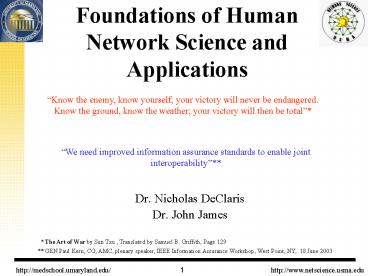Foundations of Human Network Science and Applications - PowerPoint PPT Presentation
1 / 16
Title:
Foundations of Human Network Science and Applications
Description:
'Know the enemy, know yourself; your victory will never be endangered. ... Neuron types: affereny, efferent, and inter-neurons ... – PowerPoint PPT presentation
Number of Views:32
Avg rating:3.0/5.0
Title: Foundations of Human Network Science and Applications
1
Foundations of Human Network Science and
Applications
Know the enemy, know yourself your victory will
never be endangered. Know the ground, know the
weather your victory will then be total
We need improved information assurance standards
to enable joint interoperability
- Dr. Nicholas DeClaris
- Dr. John James
The Art of War by Sun Tzu , Translated by
Samuel B. Griffith, Page 129
GEN Paul Kern, CG, AMC, plenary speaker, IEEE
Information Assurance Workshop, West Point, NY,
18 June 2003
2
Foundations of Human Network Science
- Foundational Levels of Human Network Science
- circuits of neural behaviors in a single brain,
- networks of sets of brains, and
- systems of sets of networked brains.
- Foundational brain behaviors
- The formation of ideas as the result of brain
electrical activity, and - The formation of emotions as the result of brain
glandular (chemical) activity.
3
Human Networks Achieving Autonomic Enterprise
Services
- Components are distributed in time and space
- Trust is necessarily a locally maintained
estimate - Friendly and enemy activities result in
continual system changes - The only system invariant is usually the
commanders intent
4
Human Networks Realizing Next-Generation Command
and Control
5
Human Neural Structures and FunctionsPhysiologica
l and Conceptual Aspects
- Building Units Circuit, network and System
Structures and Functions - Brain Structures and Functions
- Overview of Current Brain Functions Modeling
Approaches - Engineering Aspects
6
Building Units Circuit, Network and System
Structures and Functions
- Neuron types affereny, efferent, and
inter-neurons - Synaptic Organization Feedforward, Tract,
Pathway LayeredRecurrentReflex - Spatial Organization CNS Peripheral Cranial
Nerves (12 prs) Spinal Nerves (31 pairs) - Central Nervous System Brain Spinal Cord
- Peripheral Somatic Nervous System (PNS)
- Autonomic Nervous System (ANS)
- Sympathetic
- Parasympathetic
- Enteric
7
Brain Structures and Functions
- Spatial Organization (White and Gray Matter
Nucleus, Ganglia) - Forebrain
- Midbrain
- Hindbrain
- Human hierarchical Neural Structure
8
Overview of Current Brain Functions Modeling
Approaches
- Conceptualization of goal-oriented behavior
- Knowledge as a Hierarchical Dynamic Process
9
Engineering Aspects
- Commercially available hardware and software
- Research and experimental aids
10
- Brain Structures and Functions
- Overview of Current Brain Functions Modeling
Approaches - Engineering Aspects
11
Command and Control is a Hybrid System e.g.
Maintaining Running Estimates
Figure 5-1 of FM 2-0 Intelligence Common
Operational Picture and Running Estimates
12
References
- Aspects of Network and System Theory R.E.Kalman
and N.DeClaris (Editors) Holt, Rinehart and
Winston, 1970. - Intelligent Integration of Medical Models A
Rigorous Approach to Resolving the Dichotomy in
Medical Models , James, J. R., N. DeClaris, W.
Kohn and A. Nerode, Proceedings of the IEEE
International Conference on Systems, Man and
Cybernetics, San Antonio, Texas, 1-6 October
1994.
13
Command and Control is a Hybrid System e.g.
Autonomous Missile Control
- Common Jam Resistant Digital Targeting
- GPS for accurate search and target location.
- Data link provides targeting coordinates and BDA
to operator and allows in-flight missile
retasking - Flexible Lethality
- Multimode warhead for light armor and soft
targets - Common Vertical Launch Compatibility
- Booster rocket and mini-turbo jet sustainer
motor allows launch from same C/LU as PAM - High Capability Seeker
- LADAR seeker uses ATR
14
Target Engagements are Hybrid Systems e.g.
Ballistic Missile Engagement Sequence
15
Ballistic Missile Engagements
16
Modeling Swarms of Autonomous Missiles
Matlab-Simulink model of a formation of Multiple
UAVs avoiding multiple obstacles to engage
targets
http//www.mathworks.com/matlabcentral/fileexcha
nge/loadFile.do?objectId2212objectTypeFILE































